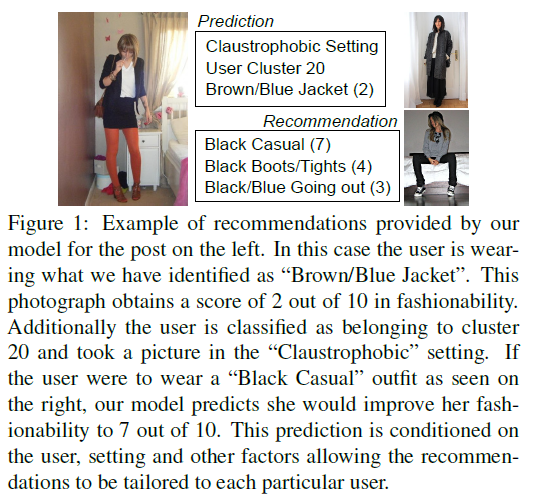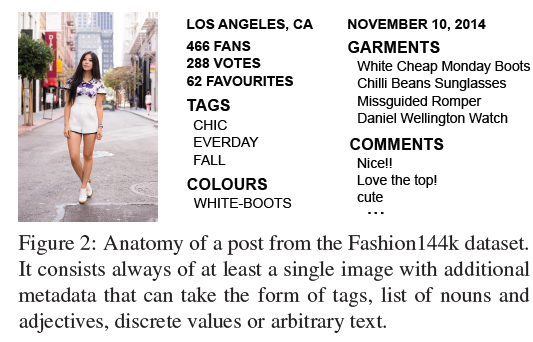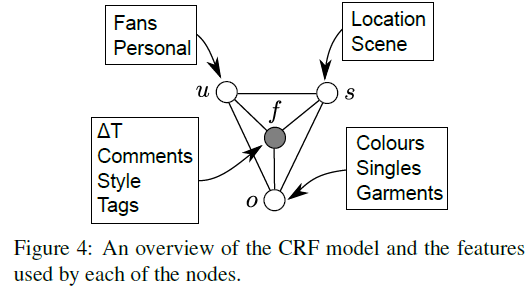CVPR 2016 paper reading (6)
1. Neuroaesthetics in fashion: modeling the perception of fashionability, Edgar Simo-Serra, Sanja Fidler, Francesc Moreno-Noguer, Raquel Urtasun, in CVPR 2015.
Goal: learn and predict how fashionable a person looks on a photograph, and suggest subtle improvements that user could make to improve her/his appeal.
This paper proposes a Conditional Random Field model that jointly reasons about several fashionability factors such as the type of outfit (全套装备) and garments (衣服) the user is wearing, the type of the user, the photograph's setting (e.g., the scenery behind the user), and the fashionability score.
Importantly, the proposed model is able to give rich feed back to the user, conveying which garments or even scenery she/he should change in order to improve fashionability.

This paper collects a novel dataset that consists of 144,169 user posts from a clothing-oriented social website chictopia.com. In a post, a user publishes one to six photographs of her/himself wearing a new outfit. Generally each photograph shows a different angle of the user or zoons in on different garments. User sometimes also add a description of the outfit, and/or tags of the types and colors of the garments they are wearing.

Discovering fashion from weak data:
The energy of the CRF as a sum of energies encoding unaries for each variable as well as non-parametric pairwise pothentials which reflect the correlations between the different random variables:


User specific features:
- the logarithm of the number of fans
- use rekognition to compute attributes of all the images of each post, keep the features for the image with the highest score.
Then compute the unary potentials as the output of a small neural network, produce an 8-D feature map.

Outfit features:
bag-of-words approach on the "garments" and "colours" meta-data

Setting features:
- the output of a pre-trained scene classifier (multi-layer perceptron, whose input is CNN feature)
- user-provided location: look up the latitude and longitude of the user-provided location, project all the values on the unit sphere, and add some small Guassian noise. Then perform unsupervised clustering using the geodesic distances, and use the geodesic distance from each cluster center as a feature.

Fashion:
- delta time: the time between the creation of the post and when the post was crawled as a feature
- bag-of-words on the "tag"
- comments: parse the comments with the sentiment-analysis model, which can predict how positive a review is on a 1- 5 scale, sum the scores for each post.
- style: style classifier pretrained on Flickr80K.

Correlations:
use a non-parametric function for each pairwise and let the CRF learn the correlations:

Similarly for the other pairwise potentials.
Learn and Inference:
First jointly train the deep networks that are used for feature extraction to predict fashionablity, and estimate the initial latent states using clustering.
Then learn the CRF model using the primal-dual method.

CVPR 2016 paper reading (6)的更多相关文章
- CVPR 2016 paper reading (2)
1. Sketch me that shoe, Qian Yu, Feng Liu, Yi-Zhe Song, Tao Xiang, Timothy M. Hospedales, Cheng Chan ...
- CVPR 2016 paper reading (3)
DeepFashion: Powering Robust Clothes Recognition and Retrieval with Rich Annotations, Ziwei Liu, Pin ...
- 浅析"Sublabel-Accurate Relaxation of Nonconvex Energies" CVPR 2016 Best Paper Honorable Mention
今天作了一个paper reading,感觉论文不错,马克一下~ CVPR 2016 Best Paper Honorable Mention "Sublabel-Accurate Rela ...
- (转)CVPR 2016 Visual Tracking Paper Review
CVPR 2016 Visual Tracking Paper Review 本文摘自:http://blog.csdn.net/ben_ben_niao/article/details/52072 ...
- Paper Reading: In Defense of the Triplet Loss for Person Re-Identification
In Defense of the Triplet Loss for Person Re-Identification 2017-07-02 14:04:20 This blog comes ...
- Paper Reading: Stereo DSO
开篇第一篇就写一个paper reading吧,用markdown+vim写东西切换中英文挺麻烦的,有些就偷懒都用英文写了. Stereo DSO: Large-Scale Direct Sparse ...
- 深度视觉盛宴——CVPR 2016
小编按: 计算机视觉和模式识别领域顶级会议CVPR 2016于六月末在拉斯维加斯举行.微软亚洲研究院在此次大会上共有多达15篇论文入选,这背后也少不了微软亚洲研究院的实习生的贡献.大会结束之后,小编第 ...
- Paper Reading - Deep Visual-Semantic Alignments for Generating Image Descriptions ( CVPR 2015 )
Link of the Paper: https://arxiv.org/abs/1412.2306 Main Points: An Alignment Model: Convolutional Ne ...
- Paper Reading - Mind’s Eye: A Recurrent Visual Representation for Image Caption Generation ( CVPR 2015 )
Link of the Paper: https://ieeexplore.ieee.org/document/7298856/ A Correlative Paper: Learning a Rec ...
随机推荐
- Angular4 step by step.1
1.官网地址 :https://angular.cn/guide/quickstart 2.在线学习地址:https://embed.plnkr.co/?show=preview 3.效果截图哇哈哈
- [android] 练习使用ListView(二)
主要练习异步任务和LruCache缓存 package com.android.test; import java.io.InputStream; import java.net.HttpURLCon ...
- Map常用集合遍历
Map集合遍历的四种方式理解和简单使用 Map集合是键值对形式存储值的,所以遍历Map集合无非就是获取键和值,根据实际需求,进行获取键和值 1:无非就是通过map.keySet()获取到值,然后根据键 ...
- 基于easyUI实现权限管理系统(四)——用户管理
此文章是基于 EasyUI+Knockout实现经典表单的查看.编辑 一. 相关文件介绍 1. user.jsp:用户管理界面 <!DOCTYPE html PUBLIC "-//W3 ...
- spring和jdbc结合的一个小例子
1.新建一个SpringJdbc的maven项目. 2.引入需要的jar包的依赖 <span style="white-space:pre"> </span> ...
- mongodb使用实践---mongodb+mongo-java-driver+morphia
package com.lolaage.dals.dbfactory.mongodb; import java.net.UnknownHostException; import java.util.A ...
- 使用dojo.connect()添加事件的注意事项
使用dojo.connect()添加事件处理器是很方便的,不用再考虑跨浏览器的问题了.但要想正确地使用这个方法,仍然要注意几个问题: 1.用dojo.byId()获取的是dom元素,而用 ...
- myeclipse 下载 checkstyle 引入后不显示问题
参照这篇博客,http://blog.csdn.net/zzq900503/article/details/42003499 下载最新的checkstyle版本后,在本地导入后一直不显示,步骤什么的也 ...
- 红黑树(R-B Tree)
R-B Tree简介 R-B Tree,全称是Red-Black Tree,又称为“红黑树”,它一种特殊的二叉查找树.红黑树的每个节点上都有存储位表示节点的颜色,可以是红(Red)或黑(Black). ...
- linux 下apche无法监听端口解决办法(Permission denied: make_sock: could not bind to address)
想建立一个测试用的虚拟主机,遇到了这个问题:[root@localhost html]# service httpd startStarting httpd: httpd: Could not rel ...
